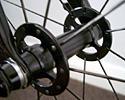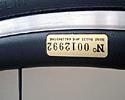
Recently on Cyclingnews.com |
Tech review - April 24, 2004
On test: FSA RD-400 wheels, Carbon Superlight cranks & Platinum Pro Ti bottom bracket
Full speed ahead with Full Speed Ahead

|
This year, no less than 16 professional teams will be using Full Speed Ahead (FSA) products of one kind or another - Alessio-Bianchi, Chocolade Jacques, Credit Agricole, Euskaltel-Euskadi, Quick.Step-Davitamon, Saeco, Team CSC, and Domina Vacanze to name just a few. So what makes them so popular? Anthony Tan puts three of their products through their paces in an attempt to find out why.
In the last few years, FSA (Full Speed Ahead) parts and accessories have spread throughout the pro peloton faster than the plague. With two of the top five UCI teams and three of the top 10 UCI riders using FSA and sister company VisionTech components in 2004, the riders using FSA-branded stuff reads like a who's who of pro cycling.
Based in the Seattle, Washington area with a European office located in Milan, Italy, the company is probably best known for their very purdy carbon fibre cranksets and anodized chainrings. However, the firm's range extends to bottom brackets, headsets, handlebars, stems, seatposts, seats, aerobars, brake levers and wheels. So apart from free schwag for the riders that looks cool too, why are so many teams using FSA's products, and is it justified in performance terms? I've tried to answer these questions, at least in part, by testing three items in their range: FSA's RD-400 wheels, the FSA Carbon Superlight road crank, and the FSA Platinum Pro Ti bottom bracket.
Part I: FSA RD-400 wheels
Part II:
FSA Carbon Superlight road crank and FSA Platinum Pro Ti bottom bracket
FSA RD-400 wheels
Sitting roughly in the middle of their range of four wheelsets, FSA's RD-400 wheels combine old and new ideas about wheel-building into a lightweight pair of hoops. From the old school comes the standard spoking (that is, not paired) with 20 radial spokes up front and 24 in the rear (two-cross on the drive side and radial on the left). More moderne are the aero spokes and hidden-nipple design, which sees the spoke nipples tucked inside the Orca rims. The nipples are fitted upside-down and a special spoke key (included with the wheel) is used to reach down the spoke well to tension them, conceived in a similar vein to the Reynolds Stratus DV carbon road wheels we reviewed earlier this year for maximum aerodynamics.
Each pair of RD-400 wheels is built by hand and individually numbered. Other design features include an aluminium alloy cassette body that can be swapped to convert from Shimano to Campagnolo compatibility. FYI, I'm running on Shimano Dura-Ace nine-speed; changing cassette bodies was a piece of cake with minimal adjustment required as my local mechanic fine-tuned the gears.
The ride
|
|
|
|
|
This was always going to be interesting. My current wheels are some of the lightest around, American Classic's 350 road wheels, but I often swap the front with the heavier but more durable Mavic Classics Pro to sustain the punishment Sydney's roads so willingly offers its inner-city cycling population. I'm not going to try and do any lengthy comparisons between various wheelsets I've ridden on, but just to give you an idea of where the RD-400 sits weight-wise, at a claimed 1450 grams per pair (excluding skewers), they're 95 grams heavier than my American Classic 350 road wheels, and 40 grams lighter than the 2004 model Mavic Ksyrium clinchers.
95 grams isn't a great deal - actually, non-existent when I substitute the front with my Mavic Classics Pro - so my first impressions were not one of greater rotating mass, but rather a feeling of increased stiffness. So stiff, in fact, that I found them a little too stiff for training purposes (however, this also depends on your choice of tyres and tyre pressure, frame type/material and a few other extraneous influences.) And with a semi-aero rim (I measured 27mm), the RD-400s rolled easily too without being over-sensitive in crosswinds, unlike most deeper-rim wheelsets.
Freewheeling on these wheels was, well, interesting. In all my years of riding, I'd never had so many heads turn as the aluminium cassette body spun freely on the rear hub, making a lovely, noisy, whirring sound that would put the noisest Campagnolo cassette bodies to shame. Now this detail may seem trivial at best, perhaps even superficial, but judging from the number of questions I was asked during my ten-week test period, I now know that it's not. Like it or not, recreational cycling is a lot about being seen, and when seen, looking, feeling, and sounding go-oood.
Out of the saddle, these hoops could do no wrong; I would even go so far as to say they tease the sprinter out of you. (By the way, I'm a 71 kilo has-been amateur racer that used to relish climbs and detest sprints.) On shorter climbs, the wheels performed admirably with no noticeable flex, though on hills more than 3-4 kilometres long, I did feel a little bogged down. Again, something virtually impossible to measure, and a factor that could well have something to do with my inconsistent level of fitness nowadays, but after two-and-a-half months' continuous testing, that's the conclusion I came to.
Finally, braking. Apt that I wrote this part of review today, as it was only yesterday afternoon that saw me tug my brakes with all my might, as out of nowhere, a massive German shepherd bolted across the road in peak hour; I managed to stay upright (though only just), but one thing I noticed as my heart made its way back from my mouth was that these wheels hardly locked up at all. Whether a carbon brake surface would have fared so well under similar circumstances is debatable - particularly in wet weather - but I was happy to have the security and predictability of the aluminium braking surface on this and numerous other occasions.
Conclusion
A great wheel, best suited for criteriums and fast, undulating road races where big gear, out-of-the-saddle sprinting and climbing is common. The clincher option keeps costs down and changes fuss-free when punctures occur. Possibly a tad unforgiving for some as a training wheel, though very light and super-stiff notwithstanding. And very importantly, these hoops did not require any truing after almost three months, nor did they make any unwanted noises. Excellent value at €490 (approx. US$ 580).
Weight: 1450 grams per pair
Recommended retail price: €490
Pro: Light, rigid, fast, excellent braking, good-looking, ambient noise
a head-turner!
Con: A little unforgiving on harsher roads
More information: Full
Speed Ahead website
Cyclingnews Rating: ![]()
Part II: FSA Carbon Superlight road crank and FSA Platinum Pro Ti bottom bracket




